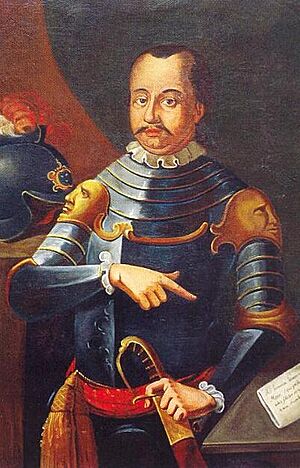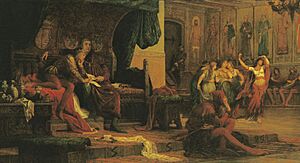Ulrich II, Count of Celje facts for kids
Quick facts for kids Ulrich of Celje |
|
|---|---|
| Count of Celje, Ortenburg and Zagorje | |
 |
|
| Portrait (from ca. 1700) | |
| Coat of arms | |
| Holding(s) | County of Celje, Slavonia |
| Spouse(s) | Katarina Branković |
| Issue | |
| Hermann IV Elizabeth Catherine George Albert |
|
| Noble family | Counts of Celje |
| Father | Frederick II of Celje |
| Mother | Elizabeth of Frankopan |
| Born | 16 February 1406 Krško |
| Died | 9 November 1456 (aged 50) Belgrade |
Ulrich II (born February 16, 1406, died November 9, 1456), also known as Ulrich of Celje, was a very powerful noble from a family called the Counts of Celje. He was the last count of Celje to hold a special title called "Princely Count."
When he died, Ulrich was like a top leader in the Kingdom of Hungary. He was the main general and almost the actual ruler. He also governed large areas in places like Slovenia, Croatia, Bosnia, Austria, and Slovakia. He even wanted to become king of Bosnia.
Ulrich was killed by people connected to the Hunyadi family. This caused a lot of trouble in Hungary. The problems ended about a year later when the young king, Ladislas the Posthumous, died suddenly. Then, Matthias Corvinus, who was Ulrich's son-in-law and the son of John Hunyadi, became the new king. After Ulrich's death, his lands in the Holy Roman Empire went to Emperor Frederick III. His lands in Hungary went back to the king.
Contents
Ulrich's Life and Rise to Power
Ulrich II was the son of Count Frederick II of Celje and his wife Elizabeth of Frankopan. Elizabeth came from a powerful Croatian family. Not much is known about Ulrich's early life. On April 20, 1434, he married Kantakuzina Katarina Branković, whose father was the ruler of Serbia.
Ulrich quickly became very important in the Kingdom of Hungary and the Holy Roman Empire. He even became more influential than his own father. In 1436, the Emperor Sigismund gave Ulrich and his father the title of "Prince of the Empire."
This made the House of Habsburg in Austria unhappy because they felt their rights over Celje were ignored. However, Ulrich later made an alliance with the Habsburg King Albert II of Germany. King Albert even made Ulrich his special helper in Bohemia for a short time.
When King Albert died in 1439, Ulrich supported Albert's wife, Elizabeth of Luxembourg. He helped crown her baby son, Ladislaus the Posthumous, as the new king of Hungary in 1440.
Conflicts and Final Days
Ulrich had many disagreements with the powerful Hungarian Hunyadi family. One big problem was when John Hunyadi lost a battle against the Ottoman Empire in 1444. Ulrich did nothing to help. Another issue was that Hunyadi did not agree with Ulrich's claim to rule Bosnia after King Tvrtko II died in 1443.
In 1446, John Hunyadi, who was then the ruler of Hungary, attacked Ulrich's lands in Croatia and Slavonia. But Hunyadi's power weakened after he lost the Second Battle of Kosovo in 1448. This allowed Count Ulrich to lead a successful military campaign into Hungary in 1450.

In 1452, Ulrich managed to get Emperor Frederick III to give the young King Ladislaus into his care. This meant Ulrich was practically ruling Hungary. In 1454, Ulrich became even more powerful when he inherited his father's huge wealth.
After John Hunyadi died during the Siege of Belgrade in 1456, King Ladislaus made Ulrich the Captain General of Hungary. This was a very important job that Hunyadi used to have.
But Ulrich's success did not last long. On November 8, he entered the fortress of Belgrade with King Ladislaus. The very next day, Ulrich was killed by people working for László, John Hunyadi's son. The exact reasons for his death are not fully known. With Ulrich's death, the male line of the Counts of Celje family ended.
Ulrich was buried in the Minorite Church of St. Mary in Celje. A famous speaker named Johann Roth gave a speech at his funeral.
After Ulrich died, his widow Catherine, his son-in-law Matthias Corvinus, and Count John of Gorizia all tried to claim his lands. However, Emperor Frederick III ended up with them because he outlived the others.
Ulrich's Possessions
Ulrich II was incredibly wealthy and owned a vast amount of land. When he died, he controlled about 12 towns, 30 market towns, and 125 castles. Many of these were in Carinthia, Carniola, Slavonia, and Styria. He owned about one-third of all the castles in what is now Slovenia at that time.
Here are some of his most important properties:
Castles and Fortresses
- Bela Peč Castle (now in Italy)
- Čakovec Castle (now in Croatia)
- Celje Castle (now in Slovenia)
- Old town Đurđevac (now in Croatia)
- Hartneidstein Castle (now in Austria)
- Hohenburg (now in Austria)
- Kostel Castle (now in Slovenia)
- Krško Castle (now in Slovenia)
- Landskron Castle (now in Austria)
- Leskovec Castle (now in Slovenia)
- Liemberg Castle (now in Austria)
- Lobor (now in Croatia)
- Lož Castle (now in Slovenia)
- Medvedgrad (now in Croatia)
- Metlika Castle (now in Slovenia)
- Ortenburg Castle (now in Austria)
- Ojstrica Castle (now in Slovenia)
- Ortnek Castle (now in Slovenia)
- Burg Perchtoldsdorf (Austria)
- Podsreda (now in Slovenia)
- Polhov Gradec Castle (now in Slovenia)
- Prägrad Castle (now in Austria)
- Samobor Castle (now in Croatia)
- Skrad Castle (Croatia)
- Slovenska Bistrica Castle (now in Slovenia)
- Smlednik (now in Slovenia)
- Sommeregg Castle (now in Austria)
- Trakošćan Castle (now in Croatia)
- Trsat (Croatia)
- Veliki Tabor Castle (now in Croatia)
- Weißenegg Castle (now in Austria)
- Žovnek Castle (now in Slovenia)
- Žužemberk (now in Slovenia)
Cities and Towns
- Bakar (Croatia)
- Bardejov (now in Slovakia)
- Bužim (now in Bosnia)
- Celje (now in Slovenia)
- Čakovec (now in Croatia)
- Črnomelj (now in Slovenia)
- Dravograd (now in Slovenia)
- Đurđevac (now in Croatia)
- Gornji Grad (now in Slovenia)
- Gradec (now part of Zagreb, Croatia)
- Jesenice (now in Slovenia)
- Kočevje (now in Slovenia)
- Koprivnica (now in Croatia)
- Košice (now in Slovakia)
- Krapina (now in Croatia)
- Krško (now in Slovenia)
- Krupa (now in Bosnia)
- Laško (now in Slovenia)
- Lepoglava (now in Croatia)
- Levoča (now in Slovakia)
- Lurnfeld (now in Austria)
- Metlika (now in Slovenia)
- Millstatt (now in Austria)
- Oberdrauburg (now in Austria)
- Paternion (now in Austria)
- Považská Bystrica (now in Slovakia)
- Radovljica (now in Slovenia)
- Ribnica (now in Slovenia)
- Rogatec (now in Slovenia)
- Samobor (now in Croatia)
- Slovenska Bistrica (now in Slovenia)
- Spittal (now in Austria)
- Steničnjak (now in Croatia)
- Šoštanj (now in Slovenia)
- Trenčin (now in Slovakia)
- Varaždin (now in Croatia)
- Vrbovec (now in Croatia)
- Vuzenica (now in Slovenia)
- Žalec (now in Slovenia)
Marriage and Children
On April 20, 1434, Ulrich married Princess Katarina Brankovic of Serbia. Her father was Đurađ Branković, the ruler of Serbia. Through this marriage, Ulrich became related to the Ottoman sultan Murad II.
Ulrich and Katarina had five children. Sadly, all of them passed away before their parents did:
- Herman IV of Celje (1439 – 1452)
- Georg (around 1444 – 1445)
- Albert (died 1448)
- Catherine (1441 – 1441), who was Elizabeth's twin sister
- Elizabeth of Celje (1441 – 1455), who was Catherine's twin sister and the first wife of Matthias Corvinus of Hungary
See also
 In Spanish: Ulrico II de Celje para niños
In Spanish: Ulrico II de Celje para niños

